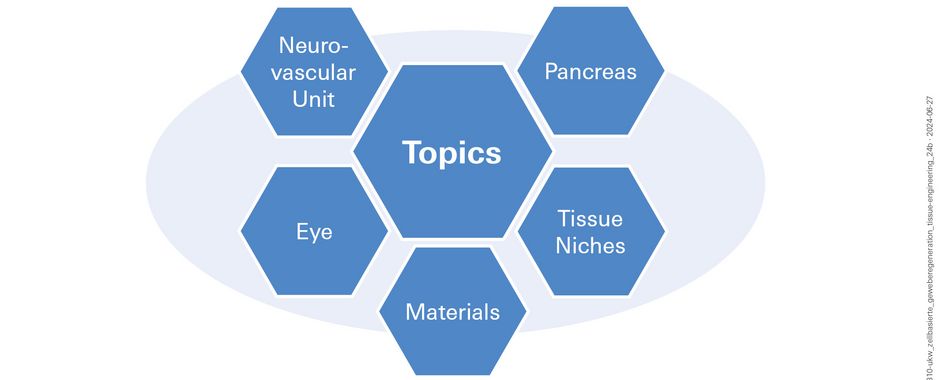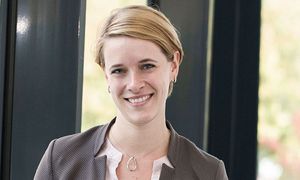Cell-based tissue regeneration
The focus of our research group is on the development of functional human tissue and organ models. We are particularly interested in the neurovascular unit and the blood-brain barrier, the pancreas, the eye, the skin and tissue niches.
The research aim in our group is to understand the complex tissues in a healthy state in order to utilize this knowledge for the investigation of disease processes and the regeneration of tissues. Examples include the differentiation of stem cells and other cells, interaction studies with biological or other materials and immune cells as well as penetration and infection studies, which investigate how pathogens penetrate tissue and cause infections.
In addition, these models can be used as alternative test systems in preclinical studies for the evaluation of active substances and the development of drugs or vaccines. They therefore contribute significantly to the implementation of the 3R principles in animal experiments. 3R stands for Replace, Reduce, Refine. The aim is to avoid animal experiments, significantly reduce their number or optimize their usage in a targeted manner. The tissue models also help to make cell-based implants usable as an alternative to conventional therapeutic strategies in the future.
Awards for alternatives to animal testing
Physiological tissue models represent a highly interesting and scientifically recognized alternative to animal testing. In this context, some of our established test systems for cell-based tissue regeneration as a replacement for animal experiments have already received great public and scientific attention: These include the Lush Prize 2016, the EPAA 3Rs Science Prize 2018, the Hugo Junkers Prize 2020, the Felix Wankel Prize 2021 and the Ursula M. Händel Prize 2022, which was awarded to the Würzburg Initiative 3R (WI3R) by the German Research Foundation (DFG). It reflects the great success of the interdisciplinary research team of the Chair of Tissue Engineering and Regenerative Medicine (TERM) and the Fraunhofer Translational Center for Regenerative Therapies (TLC-RT).
Current projects

2023
Holst MR, de Wit NM, Ozgür B, Brachner A, Hyldig K, Appelt-Menzel A, Sleven H, Cader Z, de Vries HE, Neuhaus W, Jensen A, Brodin B, Nielsen MS (2023)
Subcellular trafficking and transcytosis efficacy of different receptor types for therapeutic antibody delivery at the blood‒brain barrier.
Fluids Barriers CNS. 2023 Nov 6;20(1):82.
doi: 10.1186/s12987-023-00480-x. PMID: 37932749; PMCID: PMC10626680.
Haferkamp U*, Hartmann C, Abid CL, Brachner A, Höchner A, Gerhartl A, Harwardt B, Leckzik S, Leu J, Metzger M, Nastainczyk-Wulf M, Neuhaus W, Oerter S, Pless O, Rujescu D, Jung* M, Appelt-Menzel A* (2023).
“Human isogenic cells of the neurovascular unit exert transcriptomic cell type-specific effects on a blood-brain barrier in vitro model of late-onset Alzheimer disease.” Fluids Barriers CNS. 2023 Oct 31;20(1):78.
Hartl N, Gabold B, Adams F, Uhl P, Oerter S, Gätzner S, Metzger M, König AC, Hauck SM, Appelt-Menzel A, Mier W, Fricker G, Merkel OM (2023).
“Overcoming the blood-brain barrier? - prediction of blood-brain permeability of hydrophobically modified polyethylenimine polyplexes for siRNA delivery into the brain with in vitro and in vivo models.”
J Control Release. 2023 Aug;360:613-629.
Schalla MA, Oerter S, Cubukova A, Metzger M, Appelt-Menzel A, Stengel A (2023)
“Locked Out: Phoenixin-14 Does Not Cross a Stem-Cell-Derived Blood-Brain Barrier Model.”
Brain Sci. 2023 Jun 22;13(7):980.
Schwebler J, Fey C, Kampik D, Lotz C (2023)
Full thickness 3D in vitro conjunctiva model enables goblet cell differentiation. Sci Rep. 2023 Jul 28;13(1):12261. doi: 10.1038/s41598-023-38927-8
Dembski S, Schwarz T, Oppmann M, Bandesha ST, Schmid J, Wenderoth S, Mandel K, Hansmann J (2023)
Establishing and testing a robot-based platform to enable the automated production of nanoparticles in a flexible and modular way.
Sci Rep. 13(1) (2023),11440.
doi: 10.1038/s41598-023-38535-6
Weigel T, Christ B, Dembski S, Ewald A, Groneberg D, Hansmann J, Luxenhofer R, Metzger M, Walles H, Willy C, Groeber-Becker F, Probst J (2023)
Biomimetic Connection of Transcutaneous Implants with Skin.
Adv. Healthcare Mater, 2301131.
doi: 10.1002/adhm.202301131
Feigl FF, Stahringer A, Peindl M, Dandekar G, Koehl U, Fricke S, Schmiedel D (2023).
Efficient Redirection of NK Cells by Genetic Modification with Chemokine Receptors CCR4 and CCR2B.
Int J Mol Sci. 2023 Feb; 24(4): 3129.
Kaltdorf M, Breitenbach T, Karl S, Fuchs M, Kessie DK, Psota E, Prelog M, Sarukhanyan E, Ebert R, Jakob F, Dandekar G, Naseem M, Liang C, Dandekar T (2023). Software JimenaE allows efficient dynamic simulations of Boolean networks, centrality and system state analysis.
Sci Rep. Feb 2023; 13: 1855.
Däullary T, Imdahl F, Dietrich O, Hepp L, Krammer T, Fey C, Neuhaus W, Metzger M, Vogel J, Westermann AJ, Saliba AE, Zdzieblo D (2023)
A primary cell-based in vitro model of the human small intestine reveals host olfactomedin 4 inducton in response to Salmonella Typhimurium infection.
Gut Microbes. 2023 Jan-Dec;15(1).
Zubiaga L, Briand O, Auger F, Touche V, Hubert T, Thevenet J, Marciniak C, Quenon A, Bonner C, Peschard S, Raverdy V, Daoudi M, Kerr-Conte J, Pasquetti G, Koepsell H, Zdzieblo D, Mühlemann M, Thorens B, Delzenne ND, Bindels LB, Deprez B, Vantyghem MC, Laferrère B, Staels B, Huglo D, Lestavel S, Pattou F (2023)
ral metformin transiently lowers post-prandial glucose response by reducing the apical expression of sodium-glucose co-transporter 1 in enterocytes.
iScience. 2023 Jan25;26(4):106057.
Koziolek M, Augustijns P, Berger C, Cristofoletti R, Dahlgren D, Keemink J, Matsson P, McCartney F, Metzger M, Mezler M, Niessen J, Polli JE, Vertzoni M, Weitschies W, Dressman J (2023)
Challenges in Permeability Assessment for Oral Drug Product Development.
Pharmaceutics. 2023; 15;
doi: 10.3390/pharmaceutics15102397
2022
Koenig L, Ramme AP, Faust D, Mayer M, Flötke T, Gerhartl A, Brachner A, Neuhaus W, Appelt-Menzel A, Metzger M, Marx U and Dehne EM (2022).
A Human Stem Cell-Derived Brain-Liver Chip for Assessing Blood-Brain-Barrier Permeation of Pharmaceutical Drugs.
Cells. 2022 Oct 19;11(20):3295.
Choi J*, Schmitt SM*, Oerter S, Appelt Menzel A, Schmitz T, Hansmann J (2022).
Development of a novel automated impedance measurement system for dynamic culture of induced pluripotent stem cell derived blood brain barrier endothelial cells.
Bioengineering 2022, 9 , 39.
Peindl M, Göttlich C, Crouch S, Hoff N, Lüttgens T, Schmitt F, Pereira JGN, May C, Schliermann A, Kronenthaler C, Cheufou D, Reu-Hofer S, Rosenwald A, Weigl E, Walles T, Schüler J, Dandekar T, Nietzer S, Dandekar G (2022).
EMT, Stemness, and Drug Resistance in Biological Context: A 3D Tumor Tissue/In Silico Platform for Analysis of Combinatorial Treatment in NSCLC with Aggressive KRAS-Biomarker Signatures.
Cancers (Basel). 2022 May; 14(9): 2176.
Krasemann S, Appelt Menzel A, et al. (2022).
The blood brain barrier is dysregulated in COVID 19 and serves as a CNS entry route for SARS CoV 2.
Stem Cell Reports. 2022 Jan 3:S2213 6711(21)00650 0.
Häusler J, Müller FA, Müller L, Grabow J, Cleve C, Lotz C, Röschlau M, Bittorf P, Fromme R, Kiebert I, Grüne M, Schweizer S, Dembski S (2022).
Preparation of Phosphorescent Eu2+, Dy3+-Doped Strontium Aluminate Nanoparticles by Laser Vaporization for the Modification of Therapeutic Contact Lenses.
Adv. Photonics Res., 3 (2022) 2200013,
doi 10.1002/adpr.202200013
Christ B, Glaubitt W, Berberich K, Weigel T, Probst J, Sextl G, Dembski S (2022)
Sol-Gel-Derived Fibers Based on Amorphous α-Hydroxy-Carboxylate-Modified Titanium(IV) Oxide as a 3-Dimensional Scaffold
Materials 15 (2022) 2752. doi.org/10.3390/ma15082752
Eder S, Hollmann C, Mandasari P, Wittmann P, Schumacher F, Kleuser B, Fink J, Seibel J, Schneider-Schaulies J, Stigloher C, Beyersdorf N, Dembski S (2022)
Synthesis and Characterization of Ceramide-Containing Liposomes as Membrane Models for Different T Cell Subpopulations.
J. Funct. Biomater. 13 (2022), 111.
doi: 10.3390/jfb13030111
Lee HR, Lotz C, Groeber-Becker FK, Dembski S, Novikova T (2022)
Digital histology of tissue with Mueller microscopy and FastDBSCAN.
Appl. Opt. 61, (2022) 9616-9624
doi: 10.1364/AO.473095
Al-Hejailan R, Weigel T, Schürlein S, Berger C, Al-Mohanna F, Hansmann J (2022)
Decellularization of Full Heart-Optimizing the Classical Sodium-Dodecyl-Sulfate-Based Decellularization Protocol.
Bioengineering (Basel). 2022; 9.
doi: 10.3390/bioengineering9040147
Weigel T, Malkmus C, Weigel V, Wußmann M, Berger C, Brennecke J, Groeber-Becker F, Hansmann J (2022). Fully Synthetic 3D Fibrous Scaffolds for Stromal Tissues-Replacement of Animal-Derived Scaffold Materials Demonstrated by Multilayered Skin.
Adv Mater. 2022; 34:e2106780.
doi: 10.1002/adma.202106780

